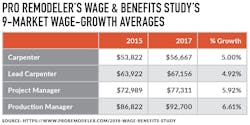It was drywalling day at the New American Remodel and by 10 a.m., two subcontracted drywallers were onsite and well into what would be a several-day job. Four hours later, they were both gone and working not just on another jobsite, but for another company. Poached.
It’s a not-so-uncommon scenario born from a climate of scarcity. Too much work and too few workers have forced contractors of all creeds and craft to look for labor in places they’re assured to find it, like a jobsite.
Facts in Figures
Spending in the residential construction industry is higher than it’s been since before the recession, but with job vacancies totaling more than 275,000, there’s not enough labor to go around.
At the peak of the mortgage crisis, when workers were fleeing to more stable industries, it took an average of 15.5 days to fill a vacant construction job opening. As of this September, the average is 20 days.
The shortage is particularly bad for remodelers, who are expecting a surge in spending over the next two years, while the laborers they most rely on-—carpenters, masons, drywallers, roofers, painters, plumbers, and so on—are in the shortest supply. It lessens the surprise of labor poaching, but amplifies its impact.
Poaching
“The reality of our industry is we are desperate,” says Mike Damora, vice president of marketing for K&B Home Remodelers and a veteran of the industry. He describes poaching like this: “A roofer is driving by a jobsite and sees two guys up working on a house. He stops and asks, ‘Can I look at your work?’ If it’s up to his standard, he offers them a job and probably more money.”
By “cash in,” Gardner is referring to how production staff and subcontractors have been leveraging the power positions current economics give them. “Workers want more money,” he says. “And they want to be paid more often.” Gardner is writing paychecks weekly now, and you can see industry-wide change in the numbers.
Since late 2016, wage growth among residential construction workers has increased from below 3% annually to 5%—now doubling the country’s average rate across all industries, according to the Labor Department. Those figures are in line with our own Wage & Benefits Study, which found that between December 2015 and December 2017, carpenter wages across the nine markets we surveyed increased an average of $2,845, or 5%.
But neither Gardner nor Damora begrudged workers seizing on an advancement opportunity. “Why would I expect them to turn down more money?” asks Damora.
It’s subcontractors that really seem to be giving the most grief. “Sometimes contractors hold the cards, and sometimes it’s subcontractors—right now, it’s subcontractors,” Gardner says. Not so long ago, the labor-demand balance was such that subcontractors prioritized their partnerships with contractors to ensure continuous work.
“They wanted to be your go-to electrician, drywaller, whatever ... their relationships with owners like me guaranteed them work [but] there are frequent renegotiations now, sometimes in the middle of a job. And if you don’t pay, they’ll break a contract and just walk off.”
Throwing Money at the Problem
Gardner laments that workers today are “almost 100% motivated by money.” Four years ago, he says, it was experience. “They wanted to grow professionally, but that’s not what we hear when we’re interviewing these days.”
That’s not to say that the demand for more money ends at new hires. Even fully staffed firms are feeling upward wage pressure in this climate. It’s already happened to New Englander Tanya Donahue, president of Rhode Island Kitchen & Bath. “A competitor approached one of our carpenters and offered him a 30% pay increase,” she says. “We can’t afford to let go of labor right now. We had to match it.”
Between 2005 and 2016, the national share of construction workers aged 24 and younger dropped Nearly 30%.
In the last 12 months, to ensure continued competitiveness, Donahue’s had to give pay raises across the board—all 24 employees. “And all were above the 3-4% cost-of-living increases that we already give.” She adds that longtime trade partners are also charging higher rates. “We’re happy for the labor, but the bigger overhead is already eating into profits,” she says. “We expect to be down a couple points by year’s end.”
With enough to throw around, money may very well be the most effective deterrent against poaching. “In most situations, more money is going to convince your workers to leave or stay,” Damora says. But when you’re not sitting on that kind of cash, as many remodelers aren’t, what are the other options?
Solving the Problem
So how can a company owner solve the problem? The short answer is that until the labor shortage is resolved, poaching is going to happen. But there are a number of steps that businesses can take to decrease the likelihood that their employees will be stolen.
Stay in Touch: Donahue has implemented stay interviews. “We don’t want any more surprises, so we’re touching base with everyone,” she says. It’s a way to gauge an employee’s mindset on everything from culture to pay. She’ll ask how they’re feeling about the company and their career path within it, as well as what their needs are. “If they’re not happy with their pay or want additional training, or need any sort of support or education, we want to know about it so we can work with them to make sure they’re happy.”
“Too many companies over-promise and under-deliver.”
The periodic meetings also give Donahue a chance to elaborate on the breadth of an individual employee’s compensation package, which she admits can sometimes elude her employees. “They see the hourly wage but not the benefits.”
That’s actually not surprising. Eighty percent of employers say that employees don’t read materials on their benefits, and of the ones that do, nearly half don’t understand what they’re reading, according to a study from the International Foundation of Employee Benefit Plans. Two in five companies have budgets specifically for explaining benefits to employees. “It’s important for us that our employees fully understand everything they get out of working for RI Kitchen & Bath,” says Donahue.
It’s a fact near the root of the labor shortage: Fewer younger people are going into construction. Between 2005 and 2016, the national share of construction workers aged 24 and younger dropped nearly 30%, according to a report in The Wall Street Journal. Forty-eight states saw declines.
“We have a farm team,” Damora says. “You have your core crew and the question is: how do you make those five guys five different crews, or even two different crews?” The answer is training and advancement. “If you find a guy with leadership qualities, you give him responsibility, let him lead a crew and help bring less skilled guys up.”
In an environment where labor is precious, a core focus of Damora’s farm system is expanding skill sets. “When it comes to something like, say, siding, hanging planks isn’t a big deal,” he says. “But it’s trim work, the skilled stuff—when you have more people who can do more things you’ll need less skilled labor.” The less-skilled work (such as hanging planks) is much more trainable.
“You have your good guys leading a crew, doing the finishing work, while you have less experienced guys doing the grunt work. There’s no need to have a five-person crew, where everyone is one of your top, most-skilled workers,” he says. The point is to create a strong bench and be ready to promote (and increase pay) whenever possible.
Give Autonomy, Provide Relevance: In Dallas, Bob Moisan has successfully fended off poachers for decades. The president of Moisan Remodeling has a 13-member production crew. “I’ve lost one guy in 25 years,” he says. “Autonomy has been huge.”
People don’t like being micromanaged. Nearly 60% of employees say they’ve worked for a micromanager, according to an Accountemps survey. Of those, more than two-thirds linked it to lowered morale, while 55% said that it directly hurt their productivity.
“None of these guys want to be babysat,” Moisan says. “We have a supervisor that will stop by the site, but mostly my guys are given tasks and then left alone to do them.”
He’s confident in his crews’ ability to work without too much oversight, partly because he knows they’re doing work they want to be doing. “Trim carpenters don’t want to do demo or framing, and framers don’t want to, or can’t, do trim,” he says. “They want to do the work they’re trained for, and so that’s the work we give them.” He also cross-trains anyone on his team who is interested.
Culture-based Hiring: Hiring employees with motivations beyond money is now a must for Gardner—and a standard Damora, Donahue, and Moisan have all independently adopted for their own companies. “If the mentality is
‘me, me, me,’ I don’t want them,” Gardner says. “Those workers are cancers to me now.”
Workers are not ignorant to the economic power an imbalanced industry grants them. How they wield that knowledge helps Gardner make hiring decisions. “You learn pretty quickly what motivates people, even in a short period of time,” he says. “Hire to create a culture of teamwork. Pay attention to the small indicators, stuff like how often they use the word ‘I’ or if they have a habit of bouncing around too much.”
Donahue also hires for culture, and gives her staff a stake in the selection. “Our hiring process is multistep,” she says. “We have an online assessment and a face-to-face portion with me where we gauge experience, goals and motivations—but our final step is the team interviews, where the rest of the staff gets to know the person.” It’s those meetings, Donahue says, that she’ll use in making her ultimate determination. “Our team is really the final say in the process, and the best litmus test for whether they’ll fit in with our culture.”
Discourage Wage Envy: Finally, despite about a quarter of companies officially prohibiting talk of wage and salary information, it is the legal right of all employees in the U.S. to openly discuss wages. It’s guaranteed by the National Labor Relations Act.
Still, we understand why companies would discourage wage discussion. “If you have pay inequality within your company, your employees are going to find out and that’s going to create envy, and possibly animosity,” says Gardner. His solution isn’t to penalize transparency—which is, again, illegal—but rather keep salaries on a relatively even keel, measuring “keel” by position. “When salaries in a position are fairly balanced, the chitchat around the matter peters out.”
Gardner says that his aim is to mostly manage expectations. “Too many companies over-promise and under-deliver. It makes an employee unhappy, the same way finding out the guy that works right next to him is making $10,000 more.”
He used to use bonuses to incentivize, but they became more like expected salary supplements. “It wasn’t a way of compensating someone for working at a level above expectation anymore,” he says. “It was just part of their salary.” But because money is such an unignorable motivator in the industry right now, he preferred to reimagine the bonus program rather than scrap it altogether. “Next year, we’re implementing a new bonus struture that will be much more prescribed by performance.”
About the Author

James F. McClister
James McClister is managing editor for Professional Remodeler.




